Employee and Team Development In Various Organisations
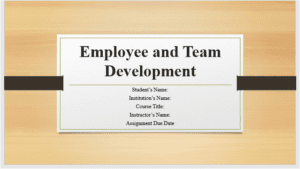
Hello, and welcome to today’s presentation. This presentation discusses employee and team development. Also, it explores the roles of teams and individuals in various organizations.
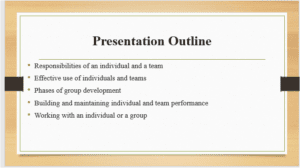
We will begin by describing the duties executed by individuals and teams in an organization. We will then explore the use of teams and individuals in an organization. We will then explain the steps involved in group development. After that, we will explore the strategies for optimizing the performance of individuals and teams. Lastly, we will explain changes in approach when dealing with a group or an individual.
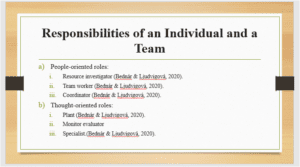
Individuals and teams play three key roles in an organization. Firstly, they perform people-oriented roles. These roles require members to have pertinent interrelation skills that create cohesion among other team members (Bednár & Ljudvigová, 2020). Examples of these roles include the resource investigator, team worker, and coordinator (Bednár & Ljudvigová, 2020). Resource investigators work in concert with the team to identify novel ideas or developments that promote the growth of the team and organization. Team workers oversee the actions of other members to establish harmony and promote the achievement of the desired goals (Bednár & Ljudvigová, 2020). Team workers address conflict among members of the team and enable them to execute their tasks effectively. Coordinators promote appropriate delegation of tasks. By so doing, they promote accountability and enable the team to focus on its objectives. Secondly, they perform thought-oriented roles. These roles are accomplished by plants, specialists, and monitor evaluators (Bednár & Ljudvigová, 2020). Plants exhibit imaginative thinking and problem-solving skills. This enables them to develop innovative strategies for handling tasks and increasing the productivity of the team and organization. Specialists offer invaluable advice in their area of expertise (Bednár & Ljudvigová, 2020). Monitor evaluators exhibit critical thinking, and objectivity and are guided by facts and evidence-based practice. They perform managerial roles and address problems that arise among team members.
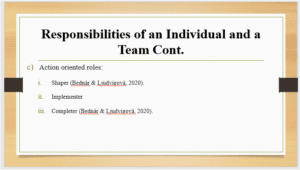
Thirdly, they perform action-oriented roles. These roles entail the timely completion of tasks based on the plan and schedule. The roles are accomplished by shapers, implementers, and completers (Bednár & Ljudvigová, 2020). Shapers are dynamic and motivate the team to accomplish its goal and objectives. These individuals occupy managerial positions. Implementers play a significant role in formulating plans and executing them in their entirety (Bednár & Ljudvigová, 2020). Completers enforce quality control and quality assurance. They evaluate tasks and services to identify aspects that should be modified to improve the quality of care.
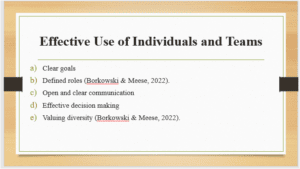
Various strategies can be embraced to optimize the actions of individuals and teams in an organization. Firstly, the formulation of clear and concise goals will allow team members to understand the intended goals and work to achieve them (Borkowski & Meese, 2022). Secondly, a clear definition of roles will avert conflict and confusion and promote accountability among team members. Thirdly, open communication will enable team members to share information and receive feedback that aims to improve the productivity of the team. Fourthly, effective decision-making enables the team to work in harmony towards a common goal (Borkowski & Meese, 2022). Effective decision-making should involve a consensus among team members. Fifthly, embracing diversity will enable team members to acknowledge the expertise, knowledge, skills, and abilities of other members. This promotes care coordination and improves the quality of care (Borkowski & Meese, 2022).
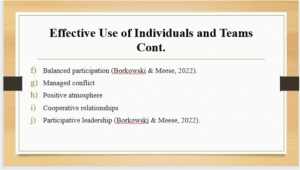
Sixthly, balanced participation enables each team member to be involved actively in the decision-making process and activities of the team. Seventhly, managed conflict ensures that each team member has an equal opportunity to express his or her concern and to receive feedback promptly (Borkowski & Meese, 2022). Eighthly, the creation of a positive atmosphere fosters trust and truthfulness and promotes creativity hence improving problem-solving among team members (Borkowski & Meese, 2022). Ninthly, cooperative relationships allow the team to recognize the ability of each member and to collaborate effectively (Borkowski & Meese, 2022). Tenthly, participative leadership allows team members to be involved in the decision-making process.
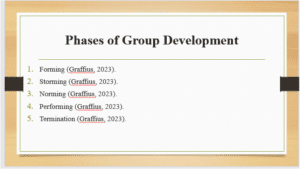
Five phases are involved in group development. The first phase is forming. This phase is marked by uncertainties and anxiety among team members (Graffius, 2023). During this stage, the team should formulate a framework and establish clear goals and objectives. The second phase is storming. This phase is marked by frustrations and disagreements among team members (Graffius, 2023). As such, members should re-focus and modify their goals and objectives to ensure that everyone is on board. Also, conflict management skills help to address disagreements exhibited during this phase (Graffius, 2023). The third phase is norming. This phase is characterized by a team that is willing to address their differences and work in concert to achieve a common goal (Graffius, 2023). The fourth phase is performing. This phase is characterized by members who can resolve problems and who exhibit satisfaction with their progress (Graffius, 2023). During this phase, team members have discovered their strengths and weaknesses and are leveraging these abilities to achieve common goals (Graffius, 2023). The fifth phase is termination. During this phase, the team accomplished its objectives and conducted a performance evaluation.
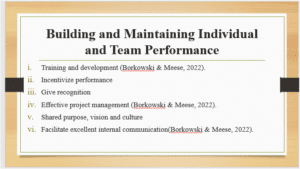
Various methods can be adopted to optimize individual and team performance. Firstly, training and development will equip team members with the knowledge and skills needed to execute their tasks (Borkowski & Meese, 2022). Refresher training benefits existing team members, whereas induction training benefits new team members. Secondly, incentives boost the morale of team members and improve individual and team performance (Borkowski & Meese, 2022). The incentives should be linked to specific, measurable deliverables. Thirdly, private recognition via text messages or emails allows the individual to recognize that their effort and hard work are appreciated (Borkowski & Meese, 2022). By so doing, team performance is improved. Fourthly, effective project management allows team members to work in harmony toward common goals objectives, and specific deliverables. Fifthly, team members should be involved in creating a positive organizational culture, purpose, and vision (Borkowski & Meese, 2022). This will allow them to remain committed to the purpose and vision hence increasing productivity. Lastly, excellent internal communication will facilitate timely information sharing, avert potential conflict and confusion, and enable the team to remain committed to a common goal.
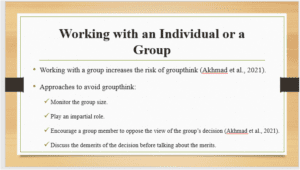
I would change my approach when working with a group. I will aim to avoid groupthink. This phenomenon is characterized by an impaired decision-making process of the group (Akhmad et al., 2021). As such, the group is likely to make undesirable decisions. To avert this, I will play an impartial role in the decision-making process to ensure that the best interventions are embraced (Akhmad et al., 2021). Also, I will advocate constructive engagement among members. For instance, I will advocate for challenging opposing views among team members before making a final decision. Furthermore, I will encourage the group to explore the potential risks of a decision before discussing its potential benefits (Akhmad et al., 2021). In this context, the benefits should outweigh the risks.
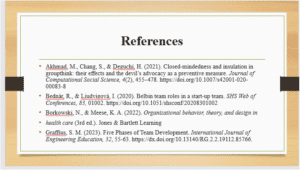
ORDER A PLAGIARISM-FREE PAPER HERE
We’ll write everything from scratch
Question 
Exam Content
As a hospital administrator, you have been tasked to increase the effectiveness of your organization through better use of your employees, both individually and in teams. Now, you and your colleagues will present your research to your hospital board. This presentation will allow you to consider a team-building approach and analyze the roles that individuals and teams play in organizations.

Employee and Team Development In Various Organisations
Preparing for the Assessment
Research employee and team development examples and approaches. Reputable references include trade or industry publications, government or agency websites, scholarly works, or other sources of similar quality.
Assessment Deliverable
Create an 8- to 12-slide Microsoft® PowerPoint® presentation with detailed speaker notes or a voice-over presentation using PowerPoint in which you:
Explain the responsibilities of an individual and a team within an organization.
Compare how individuals and teams can be used effectively in an organization.
Describe the 5 phases of group development.
Explain strategies a company can implement to build and maintain individual and team performance (e.g., individual motivation and team accolades).
Compare how your approach would change if you were working with an individual or a group.
Include a title and reference slide.
Format your in-text citations and references according to APA guidelines.
